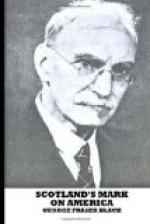In Maryland there seems to have been a colony of Scots about 1670 under Colonel Ninian Beall, settled between the Potomac and the Patuxent, and gradually increased by successive additions. Through his influence a church was established at Patuxent in 1704, the members of which included several prominent Fifeshire families. Many other small Scottish colonies were settled on the eastern shore of Maryland and Virginia, particularly in Accomac, Dorchester, Somerset, Wicomico, and Worcester counties. To minister to them the Rev. Francis Makemie and the Rev. William Traill were sent out by the Presbytery of Laggan in Ulster. Upper Marlborough, Maryland, was founded by a company of Scottish immigrants and were ministered to by the Rev. Nathaniel Taylor, also from Scotland.
Two shiploads of Scottish Jacobites taken at Preston in 1716 were sent over in the ships Friendship and Good Speed to Maryland to be sold as servants. The names of some of these sufficiently attest their Scottish origin, as, Dugall Macqueen, Alexander Garden, Henry Wilson, John Sinclair, William Grant, Alexander Spalding, John Robertson, William MacBean, William McGilvary, James Hindry, Allen Maclien, William Cummins, David Steward, John Maclntire, David Kennedy, John Cameron, Alexander Orrach [Orrock?], Finloe Maclntire, Daniel Grant, etc. Another batch taken in the Rising of the ’45 and also shipped to Maryland include such names as John Grant, Alexander Buchanan, Patrick Ferguson, Thomas Ross, John Cameron, William Cowan, John Bowe, John Burnett, Duncan Cameron, James Chapman, Thomas Claperton, Sanders Campbell, Charles Davidson, John Duff, James Erwyn, Peter Gardiner, John Gray, James King, Patrick Murray, William Melvil, William Murdock, etc.
A strong infusion of Scottish blood in New York State came through settlements made there in response to a proclamation issued in 1735 by the Governor, inviting “loyal protestant Highlanders” to settle the lands between the Hudson River and the northern lakes. Attracted by this offer Captain Lauchlin Campbell of Islay, in 1738-40, brought over eighty-three families of Highlanders to settle on a grant of thirty thousand acres in what is now Washington County. “By this immigration,” says E.H. Roberts, “the province secured a much needed addition to its population, and these Highlanders must have sent messages home not altogether unfavorable, for they were the pioneers of a multitude whose coming in successive years were to add strength and thrift and intelligence beyond the ratio of their numbers to the communities in which they set up their homes.” Many Scottish immigrants settled in the vicinity of Goshen, Orange County, in 1720, and by 1729 had organized and built two churches. A second colony arrived from the north of Ireland in 1731. At the same time as the grant was made to Lauchlin Campbell, Lieutenant-Governor Clarke granted to John Lindsay, a Scottish gentleman, and three associates, a tract of eighty thousand acres




